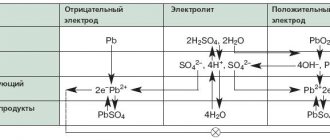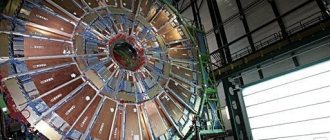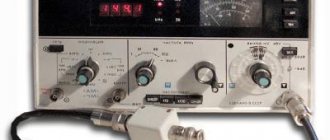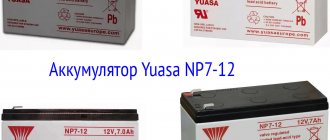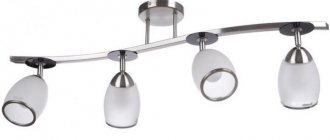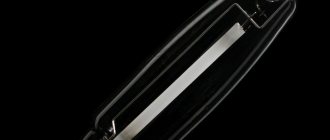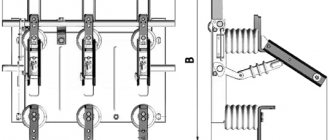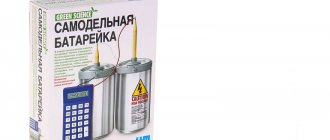Every person in the house has a device that runs on batteries. For example, a TV remote control, a children's toy, a blood pressure monitor or some other electronics. We often don't think about what types of batteries there are. We just come to the store and buy exactly the battery that we need for our device, in accordance with the instructions.
In fact, there is a wide choice on the battery market. There are batteries of types AA, AAA, C, D. But there is also a special type - this is the Krona battery, which is of type PP3. And this is not the entire list of various batteries that are in greatest consumer demand.
Battery "Krona"
In appearance, mini-batteries differ from each other only in size. All of them are cylindrical in shape, with the exception of one type (the Krona battery is a parallelepiped).
Battery separation also occurs using an electrochemical system:
- The salt battery is characterized by its fragility. Operation in high-tech devices is impossible for such batteries (20 minutes is the record time for its use). The maximum that its operation is designed for is a quartz watch or other simple and small device.
- Alkaline batteries have better performance. In high-tech devices they can work for two or three hours.
- The lithium battery has broken all records for operating time. It works for more than a month, even in the most energy-consuming devices (even with the device constantly on).
Recently, rechargeable batteries have become increasingly popular. They have different charges and can last longer, unlike regular batteries. But the main feature of batteries is their ability to restore their charge using a charger.
Such “chargers” are usually sold for a specific type of battery. However, recently, universal devices for recharging batteries have begun to appear on sale more and more often (any type can be charged, including the Krona battery).
Batteries of different shapes are designed for different devices. AA and AAA batteries are often used in remote controls, small flashlights, medical equipment and digital technology. Devices of types C and D are used for large lamps and technical devices. Children's toys often use Krona batteries.
These power supply elements also differ in type and electrochemical battery system; accordingly, their cost depends on these factors. The most expensive are rechargeable batteries (the Krona battery is also rechargeable). Salt ones have the lowest cost, while alkaline ones are sold at an average price.
Recently, manufacturers of technical devices are increasingly producing products that use the Krona battery, the price of which is low, and the charge lasts quite a long time. This is beneficial for both the manufacturer and the buyer.
Source:fb.ru/article/66430/batareyka-krona-chto-eto-i-dlya-chego-ona-nujna
What to look for before purchasing
Before purchasing, be sure to ensure that there are no visible signs of damage on the battery case. Even if there are minor defects, you should refuse the purchase.
Instructions and descriptions of parameters on the packaging must be deciphered if the battery is shipped from another country.
Before purchasing, you should also make sure that the product is not expired. If the guaranteed operation date has already expired, the battery should also not be purchased.
Sergey Firsov
Prototype Power Supply Specialist
Ask a Question
If you have any questions, you can ask our expert! Within a couple of days we will send you a response to the specified e-mail.
Technical characteristics of the Krona battery
Basic battery parameters:
- Dimensions: 48.5 mm × 26.5 mm × 17.5 mm.
- Weight is usually about 53 grams.
- Voltage - 9 V.
- The typical capacity of an alkaline battery is 625 mAh.
The Krona type battery has a capacity (according to the passport) of 0.5 Ah.
There are batteries of this form factor. With a rated operating voltage of 8.4 V, when freshly charged they can produce 11.5 V and higher for a short time, which is due to the characteristics of the Ni-MH battery cells that make them up.
- Rechargeable batteries 7D-0.125
(7D-0.1, 7D-0.11) of domestic production (diameter 24 mm, height 62 mm, weight 53 g, nominal capacity 100...125 mAh, nominal voltage 8.75 V), compatible in the shape of the contacts with the “Krona”, they were assembled from nickel-cadmium disk batteries D-0.125, D-0.1, D-0.11, respectively, were cylindrical in shape, the case was plastic. - Their dimensions are slightly larger than the standard Krona, and many domestic small-sized radios were made with this in mind.
- Some receivers (for example, “Selga”[1]) were sold complete with such a battery and charger, and the pocket receivers “Mir”[2] of 1962 and “Sokol”[3] of 1963 had a built-in transformerless charger.
Conventional disposable Krona batteries, unlike other types of chemical batteries, allowed a limited number of recharges, although this was not recommended by the manufacturer, so charger circuits were published in many magazines and books, for example, in the 1977 Encyclopedia of Young Technicians with a special form of current. Such schemes had some popularity due to the scarcity of batteries.
Types of "Kron"
The device of different types of Krona batteries, from left to right: from 6 cells of 1.5 V each, salt and alkaline, from 6 LR61 cells of 1.5 V each, from 3 lithium cells of 3 V each.
Disposable:
- Manganese-zinc salts, 6 elements
- Alkaline, 6 elements
- Lithium iron disulfide, 6 elements
- Manganese-lithium, 3 elements
- Zinc air (“Krona VTs”), 7 elements, before use it was necessary to depressurize the case - break off the thin plastic that stuck out between the contacts.
- Lithium thionyl chloride (for example, Li-SOCI2 1200 mAh[4])
Reusable (batteries):
- Ni-MH rechargeable battery of the “Crown” type, with a capacity of 170 mAh and a voltage of 8.4 V, consisting of 7 miniature batteries
- Ni-Cd 120 mAh
- Ni-MH 170—300 mAh
- Li-ION 350—700 mAh
- Recently, special types of batteries have also been commercially available.
The Krona case has a built-in Li-Po battery (one element), a step-up pulse converter with low no-load current, and a small-sized connector for charging from an external source with a voltage of 4.5-5.5 V.
This retains the advantage of the mentioned Li-Ion solution, however, no cell balancing circuit is required since only one cell is used. The output voltage is stabilized. To recharge, you do not need to look for a special charger for the Kron; any 5 V source, such as USB, is sufficient.
At the same time, for sensitive equipment (for example, radio receivers, radio microphones), pulse conversion may be unacceptable.
Design
Connectors for “Krona” type batteries In the USSR, both conventional carbon-manganese batteries of this standard size and alkaline batteries, which were more expensive and were called “Korundum,” were produced. The battery was assembled from rectangular biscuits. A metal body made of tinned sheet metal, a contact pad and a bottom made of getinax or plastic were used.
One of the contacts of the battery connector (negative) is a socket, and the second is a plug. Thus, the connector is the same for the source and the consumer, and it is impossible to connect the battery in the wrong polarity. Radio amateurs often disassembled used batteries and used their connectors in their designs.
Charging correctly
Krona batteries have a very rich history; they appeared in Soviet times, but even today they still remain a sought-after product. This battery is indispensable for gadgets with high energy consumption; the “crown” provides a much greater current when compared to any other battery. Let's take a closer look at this power source.
It’s worth starting with a description of the characteristics of the Krona battery, so that it is clearer what their feature is. This battery has a fairly high performance; the output voltage is around nine volts (for example, a AA battery, alkaline, lithium, etc., “produces” only 1.5 volts).
- The current strength of a Krona battery can reach 1200 mAh, but such elements are quite expensive. The standard power of a Krona battery is an order of magnitude lower. It is 625 mAh, but this is enough to breathe life into the gadget for a very long time.
- The capacity of rechargeable (chargeable) Krona batteries will vary depending on the type of chemical elements, and quite significantly. Let's look at their most common options. At the lower stage of evolution are Ni-Cd (nickel-cadmium) cells, their maximum capacity is only 150 mAh.
- They are followed by more modern elements with the Ni-MH classification (nickel-metal hydride), they are already produced an order of magnitude more powerful (175-300 mAh). The most capacious of all “crowns” are elements of the Li-ION class (lithium-ion).
Their power varies between 350-700 mAh. But the “crowns” have one thing in common - their size. The standard of these batteries is 48.5x26.5x17.5 millimeters.
Device and scope of application If you disassemble such a battery, you can see a rather unusual picture of the “insides” of the battery. Under the metal body of the “crown” there are six 1.5-volt batteries connected in series in one chain.
- It is in this way that it produces nine volts at the output. Having understood what a Krona battery consists of, you can once again remember the old proverb that everything ingenious is actually simple!
- And this is not surprising, because it is almost impossible to obtain such voltage and power from the chemical reaction of the battery elements in another way (after all, its case is simply small for this).
- Batteries of this type are used in control panels for devices and toys. They can also be found in various GPS navigators and even shockers. As you can see, in our age of constantly evolving technologies, you can’t do without powerful batteries!
Charging rules
Although “conscientious” battery manufacturers write that disposable batteries of this type cannot be charged, craftsmen prove the exact opposite. So, how to charge a disposable Krona battery?
There is one caveat here - you will do this at your own peril and risk, because if you choose the wrong voltage, the battery can “please” you with a wonderful fireworks display. First, we determine the charging current of our battery; to do this, we divide its capacity by ten (150 mAh / 10 = 15 mAh).
The charger voltage should not exceed 15 volts. Nowadays a lot of high-quality Chinese units are produced, where both the voltage and the current can be adjusted, so there shouldn’t be any problems with this.
Thus, you can extend the life of your “crown” by two or three cycles. Considering that it takes quite a long time to discharge, this is already very good. But keep in mind that if the elements inside the battery are dry, you will not be able to charge it again. Unfortunately, only an “autopsy” can determine this.
Save money by recharging the crowns, but do not forget that the savings should be reasonable; do not charge disposable elements more than twice!
Source: womanadvice.ru/batareyka-krona
Batteries and Accumulators Krona 9 volt
The modern world is unthinkable without such necessary devices as a flashlight, radio, and remote control. The functionality of these devices is provided by special batteries produced by many class=”aligncenter” width=”600″ height=”420″[/img]
Among the popular portable power sources, it is impossible not to mention one, the production of which began in the Soviet Union. Batteries of a similar format, which borrowed their name from their carbon-manganese predecessors, are still being produced.
Specifications
The crown is a set of six 1.5 Volt batteries connected in series. In total, the chain produces 9 volts. All elements are built into a metal or plastic case; in appearance, this device is a parallelepiped.
The most common varieties of such an element are those with the following markings: 6f22, 1604, 6r61, 6lr61, mx1604, er9v, mn 1604, am6, Corundum and others. It should be noted that connecting in the wrong polarity is almost impossible. The plus is a plug, and the minus connector contact is the shape of a socket.
The main characteristics of a 9 Volt battery are:
- Height 48.5 mm.
- Width 26.5 mm.
- Depth 17.5 mm.
- Capacity. Up to 700 mAh.
- Voltage – 9 V.
- Weight is approximately 53 grams.
Varieties and their features
Depending on the chemical compound, the following types of Crones are distinguished. A battery is a galvanic cell in which irreversible electrochemical processes occur. Recharging the products is strictly prohibited, as such actions can cause depressurization and leakage of harmful substances. Let's figure out what kind of Krona batteries there are.
- Manganese-zinc salts. Similar batteries were mass-produced by American companies already at the end of the nineteenth century.
They served as a power source for radios, automotive equipment, mining equipment, aviation and the navy. They were replaced by salt ones: ammonium chloride solution was used as an electrolyte, and the electrodes were made of manganese and zinc oxide.
Now the scale of production of such elements is being reduced. The main disadvantage of batteries is the formation of white deposits in the battery compartments, which leads to rapid failure of the equipment. In addition, grains of salt that settle as a result of depressurization can cause harm to human health.
- Alkaline. They are the next generation of batteries, also called alkaline. They differ from previous products in their higher cost and longer service life. The operation of these elements is possible even under intense loads.
- Lithium iron disulfide. They have a solid positive electrode made of a material that is better known to us as pyrite. The performance of such batteries is maintained at temperatures down to minus forty degrees. Interest in them is growing from year to year.
- Manganese-lithium. The electrode in such specimens is made of manganese dioxide. As a result of a chemical reaction, lithium oxide is formed.
- Air-zinc. The operating principle is based on the reaction that occurs during the oxidation of zinc by atmospheric oxygen. A promising, environmentally friendly version of the product also has a large capacity.
- Lithium thionyl chloride. They do not lose their performance properties at extremely low and high temperatures. Due to these characteristics, they are used in outdoor meters, surveillance systems, and electronic devices for military and aerospace purposes.
Popular manufacturers and their features
The Krona battery can be produced by many companies, but most often this battery can be found on store shelves under the following brands:
- Energizer - under this brand the Krona battery was first released and over more than half a century of history, the quality of the battery has only improved. Thanks to the use of alkaline electrolyte, the battery will last several times longer than conventional salt batteries of this type.
- Panasonic - “Krona” from a well-known manufacturer of electrical appliances is distinguished by its increased quality, which is manifested, first of all, in an increase in service life. Particularly “long-lived” are alkaline batteries, which will last 3 to 5 times longer than conventional salt batteries.
- Camelion - the battery of this company is characterized by stable operation for a long time. Ideal for devices where replacing the battery requires significant disassembly of the device case.
- Daewoo - a source of constant 9 volt electricity from this manufacturer also has good resistance to significant load.
- Varta - a battery from a well-known battery manufacturer has an increased service life.
- Samsung pleomax - a battery from this company is ideal for devices in which the electrical current consumption is not too high.
- Trophy - the products of this company also meet all the necessary requirements, therefore they can be successfully used to replace 6F22 installed in almost any electrical devices operating at a voltage of 9 volts.
- Cosmos - “Krona” from a well-known domestic manufacturer of electrical equipment is not inferior in quality to the best imported samples.
- GP – if you need to purchase a “Krona” from this manufacturer, then the best option would be the gp supercell 1604s model, which has one of the best power ratings among similar products.
In addition to the listed models, products from Robiton Minamoto and Pkcell have good capacity indicators.
Battery "Krona"
Battery "Krona"
(also 6F22 (saline), 6LR61 (alkaline), PP3, E-Block, 9V BrickBattery, AM6, 1604A, MN1604, Corundum, 522, 6AM6, CR-9V, ER9V) - this is the standard size of the batteries. The name comes from the brand of carbon-manganese batteries of this size produced in the USSR.
Specifications:
- Size: 48.5mm x 26.5mm x 17.5mm.
- Weight is usually about 53 grams.
- Voltage - 9 V.
- The typical capacity of an alkaline battery is 625 mAh.
The Krona battery has a capacity (according to the passport) of 0.5Ah. There are batteries of this form factor. They are slightly thinner in body. With a rated operating voltage of 8.4 V, when freshly charged they can produce 11.5 V or higher for a short time. This is due to the characteristics of the Ni-MH battery cells that make them up.
Rechargeable batteries 7D-0.125 (7D-0.1, 7D-0.11) of domestic production (diameter 24 mm, height 62 mm, weight 53 g, nominal capacity 100...125 mAh, nominal voltage 8.75 V), which were compatible in the shape of the contacts with the “Krona”, were assembled from nickel-cadmium disk batteries D-0.125, D-0.1, D-0.11, respectively, were cylindrical in shape, the body was plastic.
Their dimensions are slightly larger than the standard “Krona”. Many domestic small-sized radios were manufactured with this in mind. Some receivers were sold together with such a battery and charger, and in the Mir pocket receivers of 1962
1963
Falcon had a built-in charger.
Analogues of the 6F22 battery
The 6F22 battery has a fairly large number of analogues. They may have slight differences in capacity and type of electrolyte.
The most common types of Krona batteries on sale are: 1604, 6R61, 1604A, 6LF22, 6LR61, MN1604, MX1604, PP3 E-Block, Brick Battery 9V, AM6, Corundum, 6AM6, CR-9V and ER9V.
Any of the listed analogues can be used instead of the standard “Krona”, but if you need an element that will last the maximum amount of time, then you should use lithium batteries, for example, ER9V. In addition, the “Krona” varieties are very popular, the charge of which can be restored using a charger operating from a 220 V electrical network.
Battery "Krona"
Today, power sources such as batteries and accumulators have become very firmly established in human life. Thanks to them, the operation of remote controls, cell phones, cameras, flashlights and many other devices became possible. That is why the markets present a huge range of different batteries and power sources. Let's consider batteries and accumulators of the Krona brand.
Krona batteries have a very rich history. They were first released back in 1956 by Eveready, today better known as Energizer. A little later, the monopoly of this company was destroyed, as a result of which the Krona battery appeared from the Kodak and Duracell brands and other manufacturers.
This power source received its now popular name already in Soviet times. At that time, manganese-carbon batteries of non-standard size were produced under the Krona brand - 26.5 × 48.5 mm in width and height. A little later, by analogy with this “format”, all power sources began to be called “Crowns”.
Today this battery is in great demand and indispensable for gadgets. It produces a much higher current than any other battery. Let's take a closer look at such a power source as the Krona battery.
Advantages
The Krona 9v battery has the following advantages compared to a finger-type battery:
- - Greater reliability.
- — They are more compact, which means they are lighter.
And most importantly, the Krona 9v battery holds a charge for quite a long time, but it tends to self-discharge, so before you make a purchase at the market or in a store, be sure to check the date of its manufacture.
Types of "Kron"
Batteries of this size are divided into reusable (accumulators) and disposable. Disposable ones, in turn, are divided into:
- alkaline;
- manganese-zinc salts;
- lithium iron disulfide and others.
Batteries generally differ only in capacity - from 150 to 700 MPa/hour.
General information
The Krona battery (photos are given in the article) is distinguished by high performance; it produces a voltage of nine volts at the output. The size is 48.5 x 26.5 x 17.5 mm. Standard capacity is approximately 625 mAh. Weight - about 53 g.
The capacity of rechargeable batteries varies greatly depending on the chemical elements. The most common ones are:
Nickel-cadmium cells (Ni-Cd) with a maximum capacity of 150 mAh.
Nickel-metal hydride cells (Ni-MH), which are produced a little more powerful - in the range of 175-300 mAh.
Lithium-ion (Li-ION) are the most capacious cells with a capacity of 350-700 mAh.
Design of the Krona battery and scope of application
When disassembling this battery, you can see a picture that is unusual for the “insides” of ordinary batteries. Under the metal case there are 6 1.5-volt batteries connected in series in one chain, producing a total output of nine volts.
The Krona battery is used, as a rule, in control panels for toys and devices. It can also often be found in various GPS navigators and shockers.
Charging rules
Despite the fact that manufacturers of power supplies often write that batteries of this type are disposable and cannot be charged, folk craftsmen have proven exactly the opposite. How can I charge a disposable Krona battery?
- First of all, you need to make a reservation - this is done at your own peril and risk, since if the voltage is selected incorrectly, then such a battery can “delight” its owners with an unforgettable fireworks display.
- So, first of all, we determine the charging current of the battery, for which we divide its capacity by 10 (150/10 = 15 mA/h). The charger should not exceed 15 volts.
- Currently, many high-quality Chinese-made blocks are produced, where both the current strength and voltage are regulated, so there should not be any special problems with this.
Using this method, Krone can extend its life by two or even three cycles. Considering the fact that it takes quite a long time to discharge, this is already a very good result. But it should be borne in mind that if the elements inside the battery are dry, then it will no longer be possible to charge it again. But, unfortunately, only an “autopsy” can determine this.
When saving on recharging the Kron, do not forget that the savings should be within reason; you should not charge disposable elements more than 2 times!
Popular manufacturers and their features
Particularly popular in our country are products known to us under the following brands:
- Energizer. High-quality items produced for over 50 years.
- Duracell. Retains charge, is productive and durable.
- Varta. Has an increased service life.
- G.P. Some models of this brand have the highest power rating.
- Robiton. Has excellent capacity.
- Camelion. Ensures stable operation of the powered device over a long period.
- Space. Produced by a domestic manufacturer, it competes with foreign analogues.

